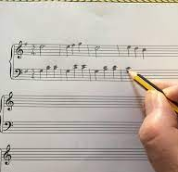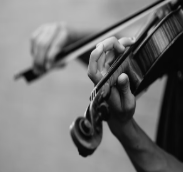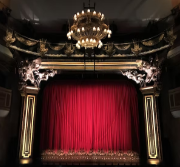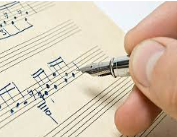The standards for Middle School Instrumental Music, Advanced Level enable students to advance technical and expressive skills. Students develop individual solutions to creative challenges through independent research, investigation, and inquiry of music idea and concepts. Students extend their knowledge of instrument-specific techniques while expanding their vocabulary of scales, arpeggios, and rudiments in more complex rhythmic patterns. Ensemble skills become more developed as students participate and collaborate with others to create and recreate music. Music literacy and performance skills are emphasized through performing and sight-reading progressively challenging literature. Students investigate connections between music skills and college, career, and workplace skills and investigate current and emerging technology in music. Opportunities are provided for students to participate in local, district, regional, and state events as appropriate to level, ability, and interest. Performances are an important part of the group activities. After-school rehearsal and performances may be required of students.
Orchestra 7 or Director's Approval
Essential Questions: How do I connect with, respond to, perform, and create music?
|
Quarter |
Quarter 1 |
Quarter 2 |
Quarter 3 |
Quarter 4 |
|
Unit Title |
Read, Write, & Perform |
Refine, Practice, Rehearse |
Pathway to Independence |
Reflect, Explore, & Achieve |
|
Image Cue |

|

|

|

|
|
Focus of the Story |
We begin the year with technical fundamentals, and a performance requirement for the entire Jr. District Orchestra selection. Students will delve into music theory concepts and practice rhythmic dictation exercises. |
We now focus on increasing rigor and expanding left and right hand technique to achieve more demanding Winter Concert literature. Students will continue to add new and more challenging scales to their repertoire. |
We now move to District Assessment during music in our schools month where students will prepare exciting literature to perform for a panel of adjudicators. Students will receive constructive feedback and undergo self-reflection. Students will also extend their range adding additional pitches to single-octave scales they have learned. |
We end our year with an exploration of solo and small ensemble literature, individual composition projects, and preparing a new scale approach for the upcoming Senior Regional Orchestra Auditions in high school. |
|
Transfer Goals |
Understand and apply creative processes to guide the development of ideas, original works, and musical performance. Analyze, interpret, and evaluate musical works from a variety of cultures. Curate a portfolio of accomplishments, experiences, and performance materials exhibiting oneself as an artist. Use music literacy to demonstrate understanding of the elements of music and the ways they inform artistic performance and creative expression. Use technology as a strategic mechanism for improving music literacy and improving music performance. |
Understand and apply creative processes to guide the development of ideas, original works, and musical performance. Analyze, interpret, and evaluate musical works from a variety of cultures. Understand and find meaning in music as a form of community engagement through involvement as a performer, supporter, advocate, and audience member. Curate a portfolio of accomplishments, experiences, and performance materials exhibiting oneself as an artist. Use music literacy to demonstrate understanding of the elements of music and the ways they inform artistic performance and creative expression. Use technology as a strategic mechanism for improving music literacy and improving music performance. |
Analyze, interpret, and evaluate musical works from a variety of cultures. Understand and find meaning in music as a form of community engagement through involvement as a performer, supporter, advocate, and audience member. Curate a portfolio of accomplishments, experiences, and performance materials exhibiting oneself as an artist. Use music literacy to demonstrate understanding of the elements of music and the ways they inform artistic performance and creative expression. |
Understand and apply creative processes to guide the development of ideas, original works, and musical performance. Analyze, interpret, and evaluate musical works from a variety of cultures. Understand and find meaning in music as a form of community engagement through involvement as a performer, supporter, advocate, and audience member. Explore and connect personal interests, experiences, and aspirations through vocation, advocation, and arts patronage. Curate a portfolio of accomplishments, experiences, and performance materials exhibiting oneself as an artist. Use music literacy to demonstrate understanding of the elements of music and the ways they inform artistic performance and creative expression. Use technology as a strategic mechanism for improving music literacy and improving music performance. |
|
Learning Targets |
I can demonstrate understanding of classroom expectations and procedures. I can familiarize myself with the steps required to participate in an audition. I can read, write, and perform all Jr. District Orchestra (JDO) Major and minor scales. I can understand the STARS method of sight-reading and apply it to new music. I can identify and count in various time signatures. I can perform the entire JDO prepared piece with correct intonation and rhythms. I can reflect on my personal JDO audition. I can demonstrate various vibrato skills. I can compose and perform an 8-measure melody using a variety of rhythms. I can demonstrate proper ensemble skills and etiquette when rehearsing concert music. I can demonstrate mastery of a variety of articulations. I can explain the importance of music in the community and the impact various roles play within it. |
I can demonstrate mastery of bow control and bow weight distribution performing scales. I can extract important rhythms, articulations, bowings, and other key concepts from my concert literature and apply them in my scales and sight-reading exercises. I can apply concepts from my method book exercise to concert literature. I can explain the importance of historical relevance that various time periods and composers play on music composition. I can demonstrate understanding of whole steps, half steps, and enharmonics and how they function within a scale. I can demonstrate mastery and explain the importance of proper concert etiquette. I can read and interpret the sharps and flats and be able to derive the name of the scale from a given key signature. I can demonstrate growth in mastery throughout the year on my Mid-Year Assessment. |
I can demonstrate mastery of bow control and distribution through scales. I can apply concepts, rhythms, articulations, bowings, from my Assessment literature and apply them in my scales and sight-reading exercises. I can apply concepts from my method book to my assessment literature. I can apply new rhythms and articulations to the daily scale warm-up. I can successfully perform the District Assessment literature individually and within an ensemble. |
I can apply concepts from my spring concert literature to extending method book exercises. I can apply new rhythms and articulations to the daily scale warm-up. I can demonstrate proper concert etiquette. I can extract important rhythms, articulations, bowings, and other key concepts from my solo and/or ensemble music and apply them in my scales and sight-reading exercises. I can apply concepts from my solo and/or ensemble music to extending method book exercises. I can explore a variety of music careers through a research-based assignment. I can explore various music composition software, sound manipulation software, and electronic instruments. I can demonstrate mastery of concepts taught and learned this year through a successful End-of-Year Assessment. |
